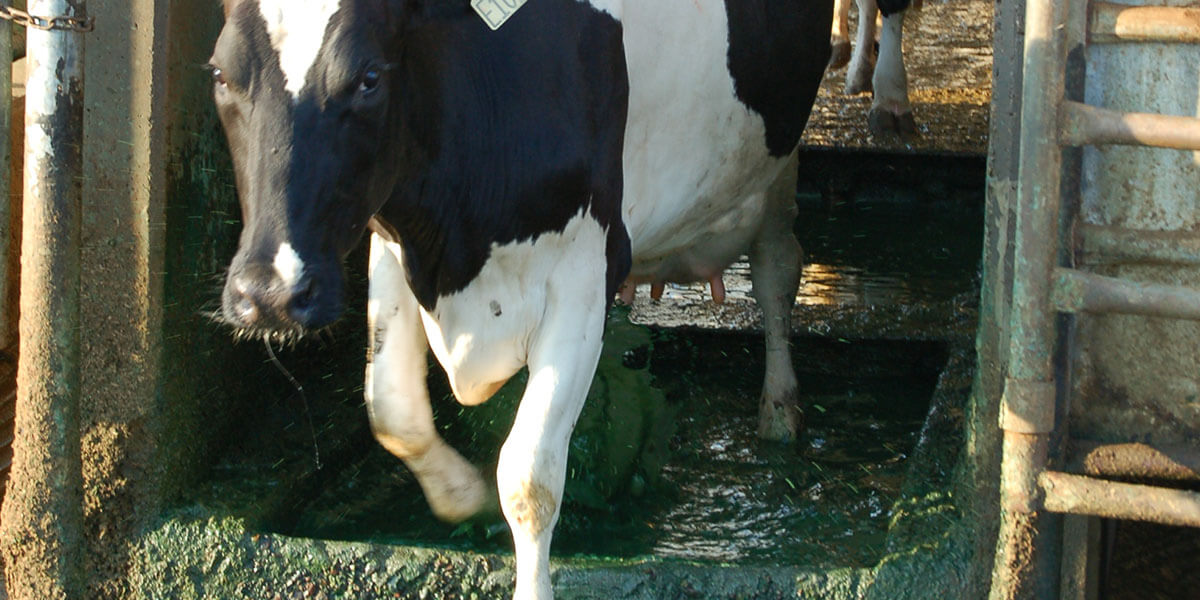Footbaths are commonly used on dairies to prevent new cases and control chronic cases of expensive cow hoof problems caused by infectious hoof diseases such as digital dermatitis, also known as hairy heel warts. Prevention is critical because digital dermatitis is a quick-moving disease that can progress from a small, subclinical lesion (less than 0.75 inch or 2 cm in diameter), to an active, acute ulcer (greater than 0.75 inch or 2 cm in diameter) in as few as 10 days and result in costs of $300 USD per cow for treatment.
Remember the Purpose of a Footbath
It’s important to keep in mind the purpose of a footbath is to prevent and control infectious foot diseases. The footbath should not be used to treat clinically affected animals. If you’ve already incurred the costs for digital dermatitis treatment in your herd, implementing an effective footbathing program will help keep the remaining chronic lesions from becoming active again, while also preventing new cases in healthy animals. By focusing on optimizing the design, location and management aspects of your footbathing program, you can reduce the frequency of footbath use while also controlling significant treatment expenses.
Design, Location and Management are Critical to Prevent Cow Hoof Problems
Footbathing allows producers to use a whole-herd approach, rather than trying to work individually with every cow. The design, location and management of the footbath are all more important considerations than the actual type of control agent (solution) being used in the footbath.
Increase the effectiveness of a footbath by keeping these points in mind:
- Locate the footbath on a level surface in an area regularly traveled by cattle, such as the exit lanes of the milking parlor. This ensures that all cows will have their feet come into contact with the entire length of the footbath solution.
- The footbath should be 10 to 12 feet (3 to 3.7 meters) long, 1.6 to 2.0 feet (0.5 to 0.6 meter) wide, with a depth of 10 inches (25 cm).
- Footbath solutions should be a minimum of 4 inches (10 cm) deep to ensure adequate coverage of the foot area.
- Footbaths should be used on consecutive days each week based on hygiene scoring. Foot and leg hygiene of the herd will help determine the number of days required. Dirtier cows require more frequent footbathing.
- A common industry standard is to change the footbath solution after every 100 to 300 cows. Frequency will vary depending on cow cleanliness, weather conditions and type of disinfectant or chemical concentration being used.
- Alternate times for replenishing footbaths with new solution so each group of cows has access to fresh solution.
- Thoroughly drain footbath and rinse with water before mixing a new solution.
- Cows should enter a clean dry area after passing through the footbath.
- On non-footbath days, keep hygiene in check with a soap bath (1 quart soap per 25 gallons of water; 1 liter of soap per 100 liters of water)
- Cows should be able to bypass permanent footbaths on days when they are not being used.

Implementing an effective footbath program that takes into consideration design, location and management best practices, such as those listed above, can help reduce costs for both prevention and treatment of infectious foot diseases such as digital dermatitis.
For more information about the proper design and management of footbaths on dairies, download the Creating & Managing an Effective Footbath brochure.
Zinpro also offers the FirstStep® Dairy Hoof Health & Management Program for customer use which includes a Hygiene and Footbath assessor to help develop footbath programs for dairy operations. You can make adjustments based on FirstStep recommendations to create a footbath program that works to optimize your herd performance.
Source: Footbath design and use recommendations are adapted from paper published in The Veterinary Journal (Cook et al., 2012) titled “Observations on the Design and Use of Footbaths for the Control of Infectious Hoof Disease in Dairy Cattle.”

